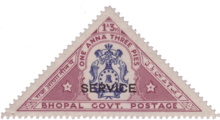
A pie (abbreviated as Ps) was a unit of currency in India, Burma and Pakistan until 1947. It was the smallest currency unit, equal to 1⁄3 of a pice, 1⁄12 of an anna or 1⁄192 of a rupee. During the mid-nineteenth century, one pie was worth 12 cowry.[1]
Minting of the pie ended in 1942, though it remained in circulation for a further five years. The pie was demonetized in 1947 as it had become practically worthless due to inflation during WW2.[note 1]
Notation
[edit]The first number is the number of rupees, the second is the number of annas (1/16), the third is the number of pices (1/64), and the fourth is the number of pies (1/192). Examples are below.
- Rs 1/15/3/2 = Rs 1.9947
- Rs 1/8/3 = Rs 1.546
- Rs 1/4 = Rs 1.25
Notes
[edit]- ^ Until 1966, India was a member of the sterling area, with the rupee pegged to the British pound sterling and having a value of 1s 6d, or 18 (old) pence; a pie was therefore worth 0.09 old pence or 3⁄8 of a farthing in 1947. In 1947, however, a single old penny had an estimated purchasing power of 14 new pence (in 2014 values). Therefore, a pie had a value of 1.3 pence in 2014. (Schedule of Par Values, Currencies of Metropolitan Areas, The Statesman's Year Book 1947, pg xxiii, Macmillan & Co.; measuringworth.com/ppoweruk/)
References
[edit]- ^ Laughlin, J. Laurence (September 1893). "Indian Monetary History". Journal of Political Economy. 1 (4): 593–596. doi:10.1086/250171. ISSN 0022-3808. S2CID 153692183.
Well, that’s interesting to know that Psilotum nudum are known as whisk ferns. Psilotum nudum is the commoner species of the two. While the P. flaccidum is a rare species and is found in the tropical islands. Both the species are usually epiphytic in habit and grow upon tree ferns. These species may also be terrestrial and grow in humus or in the crevices of the rocks.
View the detailed Guide of Psilotum nudum: Detailed Study Of Psilotum Nudum (Whisk Fern), Classification, Anatomy, Reproduction